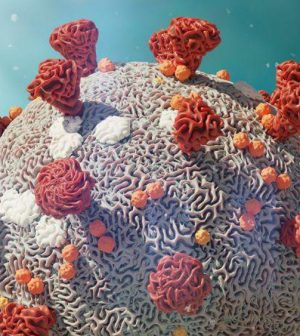- Navigating Your Midlife Crisis: Embracing New Possibilities
- City Raccoons Showing Signs of Domestication
- Mapping the Exposome: Science Broadens Focus to Environmental Disease Triggers
- One Week Less on Social Media Linked to Better Mental Health
- Your Brain Changes in Stages as You Age, Study Finds
- Some Suicide Victims Show No Typical Warning Signs, Study Finds
- ByHeart Formula Faces Lawsuits After Babies Sickened With Botulism
- Switch to Vegan Diet Could Cut Your Greenhouse Gas Emissions in Half
- Regular Bedtime Does Wonders for Blood Pressure
- Dining Alone Could Mean Worse Nutrition for Seniors
There’s a New Set of COVID Variants Called FLiRT: What You Need to Know

The virus behind COVID has mutated again, this time producing variants nicknamed FLiRT, the U.S. Centers for Disease Control and Prevention (CDC) has reported.
The variants are appearing in wastewater sampling, the CDC said, and case monitoring suggests that between April 14 and April 27, one FLiRT variant called KP.2 made up about a quarter of new COVID-19 cases.
That puts KP.2 ahead of the prior dominant strain, the JN.1 variant, which now makes up about 22% of cases, according to the CDC.
Speaking to WebMD, Dr. Megan Ranney, dean of the Yale School of Public Health, said the FLiRT variants display some concerning changes. One is alterations in the virus’ spike protein, which the virus uses to invade the body and trigger illness.
That type of change worries experts, who point to waning vaccination rates among Americans. Since September 2023, just 22.6% of Americans have gotten themselves an updated 2023-2024 COVID vaccine, the CDC said.
It’s possible that even folks who got the latest COVID vaccine aren’t well-protected against JN.1 or the FLiRT variants: One preprint study released this week from researchers at Harvard University suggests waning effectiveness against those strains. That study has not been peer-reviewed, however.
“We’ve got a population of people with waning immunity, which increases our susceptibility to a wave,” Dr. Thomas Russo, chief of infectious disease at the Jacobs School of Medicine and Biomedical Sciences at the University of Buffalo, told WebMD.
As to symptoms, folks infected with the FLiRT variant are displaying much the same symptoms that were seen with JN.1:
-
Fever or chills
-
Cough
-
Sore throat
-
Congestion or runny nose
-
Headache
-
Muscle aches
-
Difficulty breathing
-
Fatigue
-
New loss of taste or smell
-
“Brain fog” (feeling less wakeful and aware)
-
Gastrointestinal symptoms (upset stomach, mild diarrhea, vomiting)
The CDC stressed that not everyone will have any or all of these symptoms, since COVID illness varies in severity and symptoms from person to person.
More information
Learn about out the CDC’s current guidance on dealing with a COVID infection here.
SOURCES: WebMD, April 30, 2024; U.S. Centers for Disease Control and Prevention, May 8, 2024; bioRxiv, April 22, 2024
Source: HealthDay
Copyright © 2025 HealthDay. All rights reserved.










